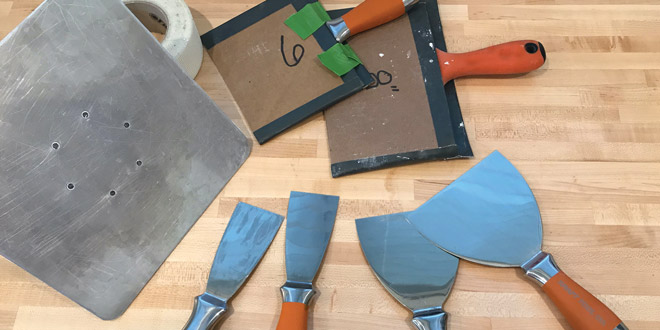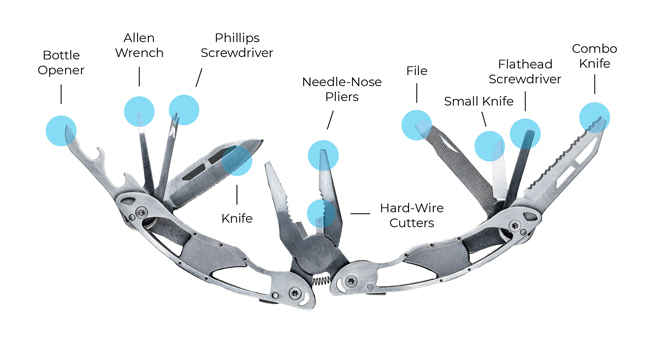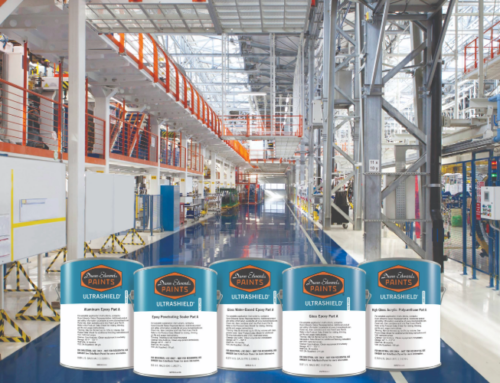While it may not hold the same real estate as other sundries like applicators or prep tools, the hand tools category is a silent workhorse. Whether your customer is a professional or DIYer, nearly every paint project requires a knife, blade or scraper to get the job done properly, and retailers who don’t stock these items may be missing out on additional sales.
Paint & Decorating Retailer spoke to a professional painter who gave us a tour into his toolbox and offered his insights and opinions on the tools he uses. Consider his experience to guide you in choosing what types and brands of these products to stock in your business.
Jack of All Trades—The Multitool
Knowing The Essentials
Aaron Holland, owner of Holland Painting in Sturgeon Bay, Wisconsin, says his two go-to hand tools are his folding utility knife and a 7-in-1 multitool. Every painter on his crew is given the same two tools, as Holland considers them essential because they can be used to accomplish many jobs at a paint site.
“The advantage of a utility knife is the blades are replaceable, so we don’t have to worry about abusing the edges or sharpening a dull blade,” Holland says. A utility knife also serves multiple purposes.
Holland says the backside of the blade can open paint cans. In addition, he uses the blade itself for cutting caulk tubes, trimming tape, paper and plastic when masking and cleaning roller frames of caked-on paint.
“I like that it has a pocket clip so it is always sitting at hand,” he says. “It is small enough to be unobtrusive when riding in the pocket, but big enough to be held in the hands with all five fingers resting on it. It can be used comfortably and safely while a good amount of force is being exerted. We have been using it daily for about 10 years.”
The multipurpose 7-in-1 tool Holland and his crew use also helps with a variety of tasks. It has regular and needle-nose pliers, a wire cutter, a combo knife with a partially serrated blade and Phillips and flathead screwdrivers.
“It is useful for pulling random nails or screws out of the wall when painting interiors, pulling off the odd plate cover that may need to be removed or unscrewing something that would otherwise necessitate a trip to the vehicle to look through the toolbox,” Holland says. “I use it several times almost every day.”
Indispensable Options
Along with those two essential hand tools, Holland’s toolbox always has knives and scrapers, as well as an entire set of plaster knives. For putty knives, Holland and his crew most frequently use a 2-inch flexible knife for patching interior nail holes and pressing tape down when taping trim.
For exterior projects, Holland turns to his 2-inch carbide scraper and 4-inch stiff straight scraper to remove paint. The type of paint he needs to remove determines whether he uses a straight blade or carbide scraper, and often he uses both.
“The straight blade scraper is good for getting under the paint and peeling it off, and it works effectively with old paint that is peeling off in sheets,” Holland says. “The carbide scraper has a very sharp blade that works best when carefully pulled across the grain. It usually removes the type of paint that the straight scraper has trouble with.”
Rounding out his toolbox, he also has 5-in-1 scrapers, a stubby razor blade scraper for cleaning glass and a full set of plaster knives for large drywall repairs and plastering walls.
“Plaster knives require a perfect edge and should be protected from damage or else they will leave trails in plaster finishes. The same knife used for scraping should not be used for plaster finishing,” Holland says. “I recently switched over to a premium solid stainless steel knife, because plaster knives are so prone to rust.”
Opportunities for Retailers
No paint store can stock every product for every customer, but most can stock the basics. Holland says his local store stocks a minimal selection that appeals to the broadest base of contractors and DIYers, but he can appreciate that they do not want to carry inventory that may not move quickly.
For retailers interested in expanding their stock or reaching additional audiences, higher-end or specialty hand tools present an opportunity for a niche category, reaching professional customers and contractors looking for tools beyond the basics.
“At this stage in my career, I am starting to gravitate toward higher-quality tools that meet a specific set of standards that reflect how I work,” Holland says. “I see myself moving toward higher quality tools, something more akin to heirloom quality, that are nicer to look at and easier to hold and use.”
Tips For New Painters—Knives and Blades
Scrape paint off windows. Utility blades are excellent for cutting paper and plastic and removing old caulk. These blades also work well for scraping dried paint off windows. If you get paint on the glass, let it dry and then use the blade to scrape off the dried paint.
Create tight tape seals. Putty knives go hand-in-hand with putty and wall repair and also create a tight seal when using painter’s tape. After you have the painter’s tape in place, run a clean putty knife over it to seal the edges and provide a clean line.
Protect your floors from paint. Drywall taping knives are used to tape up drywall seams and also work well to protect floors when painting trim. Fit the blade of the knife right between the trim and floor to keep the paint off the floor and catch any drips. It also works great in corners when you transition from one color to another.





